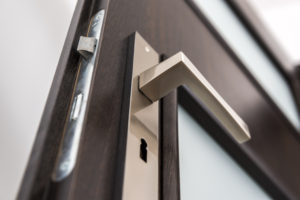
You can have the most solidly constructed, sturdy front door on the market, but if your door isn’t properly sealed, you’re in for a bad time. Even well-fitted doors will still have gaps at the header and jambs, which is why it’s standard practice to fit our entryways with gaskets and weather stripping, and why many front doors feature door sweeps.
Gaskets and weather stripping accomplish the same function, with the only difference being how elaborate the structures used are. The most common weather stripping is made of rubber and compresses when a door is closed, filling the gaps between the frame and door. Many gaskets employ a supportive, protective, metal housing, but are otherwise the same as simple weather stripping. While housed gaskets, like stop-mounted gaskets, are a little more durable, most of us will do just fine with weather stripping.
But weather stripping isn’t invincible. It can wear down, lose its elasticity and bounce, and dry out with age. Eventually, our weather stripping may be defeated by repeated opening and closing of strong doors. And when our entryways have gaps, we become subject to a host of issues.
What Can Go Wrong
There’s the weather, of course; weak, weather stripping will let in outside moisture, a potent problem in humid climes, while also letting out valuable, cool indoor air. This leakage slowly adds up. Energy bills will reflect the loss of cooled air as your air conditioning system, be it wall- or window-mounted or centralized, works harder to keep your interior cool. Those living in regions with harsh winters will be exposed to cold drafts from outside while heated air leaks from within, leading to similar high energy costs over time.
The introduction of extra air moisture from outside, or even liquid water on precipitous days and nights, will compromise any unsealed wood used in your door frame and cause damage in your entryway. Depending on the extremity of weather conditions, proper sealing might be the difference between staying dry and having to deal with a flooded floor.
Then there’s the issue of pests. Insects are like us: they like a nice, comfy shelter, and food to go with it. Unsealed gaps in your entryway doors are a perfect invitation for all kinds of crawling things, including cockroaches looking for crumbs. Depending on your location and the severity of the gaps, you could even be leaving the door open for tiny, lightning-quick mice, able to squeeze through any opening large enough for their heads. A pest infestation is never fun, and it’s one more reason to make sure your gaps are sealed.
Finally, proper sealing is important for limiting the impact of outside noise and leakage of sounds from inside your home. If you want to keep out the yelling, laughing, honking horns, and other various disturbances, and you want to preserve your privacy at the same time, proper sealing is a must.
Checking For Gaps and Leaks
First, identify your weather stripping — you should find it along the lock jamb (the side of the frame where the lock is located), along the header (the top of the frame), the threshold (where the foot of the door meets the bottom of the frame), and, uncommonly, along the hinge jamb (where the door is hinged to the frame). Weather stripping is usually not necessary at the hinge jamb — and can actually introduce problems in the operation of the door — but depending on your door and frame, and who did the installation, it may have been included.
Once you’ve located the weather stripping, check for air leaks. The dollar bill test should work well for this. (If you’re not American, your local currency should work just as well). Take the dollar bill and place it between the door and jamb where you suspect there may be a leak. Shut the door completely, then try to remove the dollar bill. If it slides out easily, your weather stripping is compromised and most likely is contributing to problematic air leaks. Consider purchasing and installing new weather stripping for your entryway door.
Sometimes weather stripping isn’t worn down, but has just been pulled loose. Inspect your weather stripping to see if it has come loose from the jamb. In many cases, the stripping can be reinserted into its kerf (a slit cut into the jamb) with little effort.
Dirt and debris can also be an issue. While you’re taking a look at your weather stripping, wipe it down with a wet rag to clear it of any dirt and debris that may be preventing it from sealing properly. This is also a good opportunity to keep an eye out for cracks and tears in the stripping. If it’s riddled with cracks and tears, your problem isn’t just dirt; you’re going to want to get new stripping.
When it comes time to get new stripping, try to bring a sample of your current stripping with you to your hardware store, or measure a sample to make sure you’re buying the right replacement online. Keep in mind a hasty contractor may have used an inappropriate gauge of stripping, in which case you should consult a professional regarding what kind should be installed in its place for better results.
Remember, ETO Doors are absolute door experts. If you have any questions about door installation, accessories, and proper door care, feel free to contact us and we’ll set you on the right course. And when on the hunt for a new front or rear entryway door, or even interior doors, be sure to browse our massive and diverse selection of doors of all styles and materials. Our solid core wood doors are second to none in craftsmanship, durability, and security, and can be delivered in all common dimensions and in styles both timelessly classic and boldly modern.


